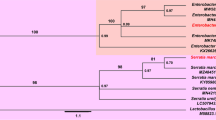Abstract
Observation on natural enemies of the stem-borer complex on sugar-cane in southern Ghana indicated that Descampsina sesamiae Mensil (Diptera:Tachinidae) is the most important larval parasite of Sesamia species. The relative abundance of this tachinid parasite appeared to vary with the rainfall pattern throughout the year and with the phenology of the sugar-cane plant. The rate of parasitism was found to be higher in the outgrowers fields than in the sugar estate’s fields. Differences in cultural practices used as well as the type of vegetation bordering the sugar-cane fields, were believed to be responsible for the difference in the rate of parasitism of D. sesamiae on Sesamia species.
Résumé
Une observation des ennemis naturels du complexe de fouisseurs à tige de la canne a sucre, au sud du Ghana, a indique que Descampsina sesamiae Mensil (Diptera: Tachinidae), est la plus importante larve parasitaire des especes de Sesamiae. L’abondance relative de ce parasite varie avec le modèle pluviométrique, pendant toute l’année, et avec l’adaptabilité de la canne à sucre aux conditions climatiques. On a trouvé que le degré de parasitisme était plus élevé dans des pousses sauvages que dans des plantations sucrières. On croit que les différences existant dans des pratiques culturelles en cours, aninsi que le type de végétation bordant le champ de canne à sucre seroient responsables de la difference du degré de parasitisme de Descampsina sesamiae, sur des espèces de Sesamiae.
Similar content being viewed by others
References
Bennett F. D. (1962) Outbreaks of Elasmopalpus lignosellus (Zell.) (Lepidoptera: Phycitidae) on sugar cane in Jamaica, Barbados and St Kitts. Trop. Agric., Trin. 397, 153–158.
Box H. E. (1935) The biological control of the sugar-cane moth borer in the Leeward Islands. With an appendix by J. G. Myers. Trop. Agric, Trin. 12, 89–96.
Maafo I. K. A. (1975) Laboratory mass rearing of exotic Tetrastichus spp. for control of maize and sugar-cane stem borers in Ghana. Ghana J. agric. Sci. 8, 89–93.
Sampson M. A. (1982) The biology of the lepidopterous stem-borers on sugar-cane (Saceharum officinarum L.) in Ghana. Ph. D thesis, University of Ghana, Legon.
Sampson M. A. and Kumar R. (1983) Population dynamics of the stem-borer complex on sugar-cane in southern Ghana. Insect Sci. Applic. 4, 25–32.
Sampson M. A. and Kumar R. (1985) Borer damage and estimation of loss caused by sugar-cane stem-borers in southern Ghana. Insect Sci. Applic. 6, 705–710.
Scheibelreiter G. K. von (1980) Sugar-cane stem borers (Lep.: Noctuidae and Pyralidae) in Ghana. Z. Angew. Ent. 89, 87–99.
Williams J. R., Metcalfe R. R., Mungomery R. W. and Mathes R. (Eds) (1969) Pests of Sugar-Cane, p. 125. Elsevier, Amsterdam.
Author information
Authors and Affiliations
Rights and permissions
About this article
Cite this article
Sampson, M.A., Kumar, R. Parasitism of Descampsina Sesamiae (Mensil) on Sesamia Species in Sugar-Cane in Southern Ghana. Int J Trop Insect Sci 7, 543–546 (1986). https://doi.org/10.1017/S1742758400009814
Received:
Revised:
Published:
Issue Date:
DOI: https://doi.org/10.1017/S1742758400009814




